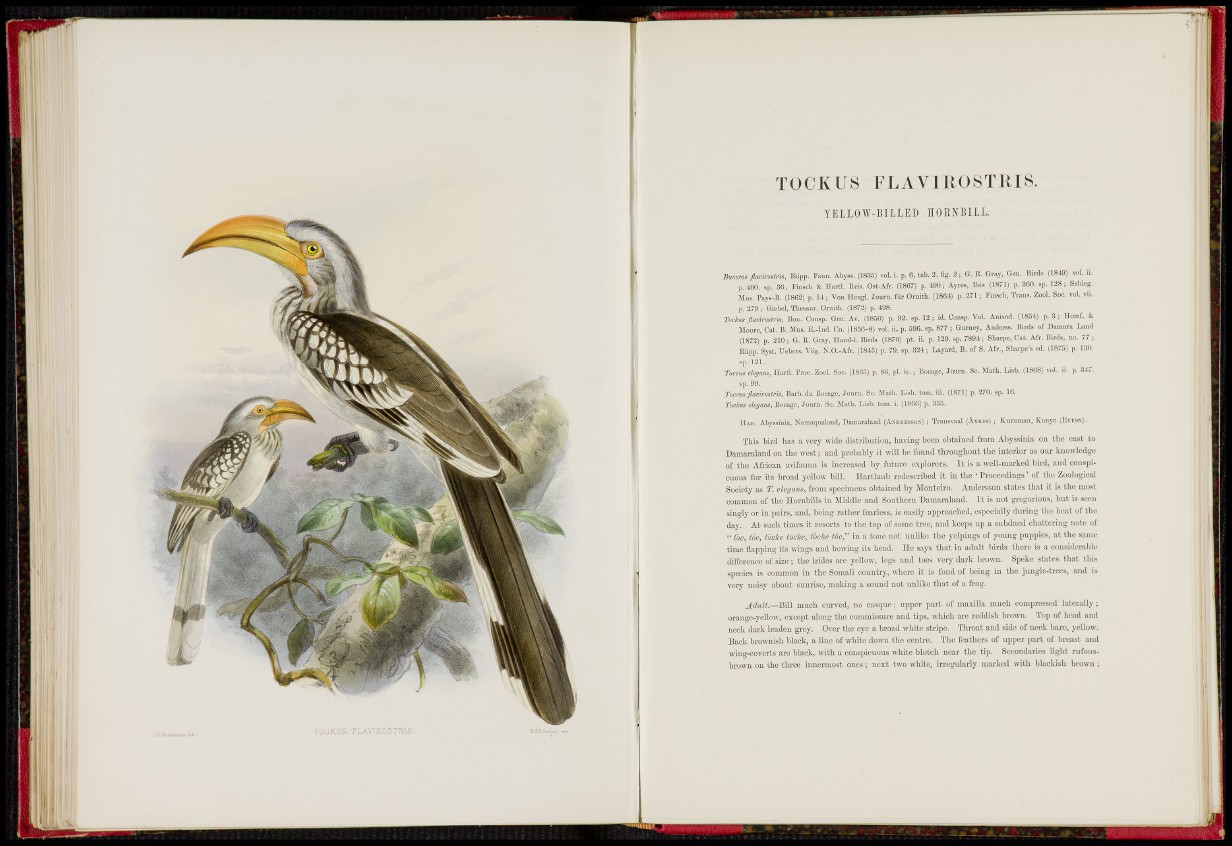
T 0 C K U S F L A V1110 S T UIS.
Y E L L O W - B I L L E l ) HOENBILL.
TOCKUS FLAVIKUSrf
Buceros flaviroslri^, Rüpp. Paim. Abyss. (1835) vol. i. p. 6, tab. 2. fig. 2; G. R, Gray, Gen. lUrds (18t9) vol. ü.
p. 400, sp. 36; Finsch & llarti. Reis. Ost-Afr. (1867) p. 490; Ayres, Ibis (1871) p. 260. sp. 128; Schleg.
Mus. Pays-B. (1862) p, 14; Von Heug!. Journ. für Orni th. (1864) p, 271; Knsch, Trans. Zool. Soc. vol. vii.
p. 279; Giebel, Tliesaur. Oraitli. (1872) p. 498.
Tockus jlavirostris, Bon. Consp. Gen. Av. (1850) p. 92. sp. 12; id. Consp. Vol. Anisod, (1854) p. 3 ; Ilorsf. &
Moore, Cat. B. Mus. E.-Ind. Co. (1856-8) vol. i i .p. 596. sp. 877; Gurney, Anderes. Birds of Daraara Laad
(1872) p. 210; G. R. Gray, Hand-l. Birds (1870) pt. ii. p. 129, sp. 7894; Starpe, Cat. Afr, Birds, no. 77;
Rüpp. Syst. Uebcrs. Vög, N.O.-Afr. (1845) p. 79. sp. 824.; Layai'd, B. of S. Afr. , Sharpe' s ed. (1875) p. 130.
sp. 121.
Toccu, elegans, Ilartl. Proc. Zool. Soc. (18G5) p. 8Ö, pl. iv, ; Booage, Journ. Sc. Math. Lisb. (1868) vol. ii. p. 347.
sp. 99.
Tuccus fiavirostris, Barb, du Bocage, .Toum. Sc. Matli, Lisb. torn. iii. (1871) p. 270. sp. IG.
Tockus elegans, Bocagc, Journ. Sc. Math, Lisb. tom. i. (1866) p. 335.
HAB. Abyssinia, Nainaqualaud, Dauiaraland (ANBERSSÜN) ; Transvaal (AYRES) ; Kurumaii, Kanye (EYTON) .
This bird has a very wide distribution, having been obtained from Abyssinia on tlie east to
Damaraland on the west; and probably it will be found throughout the interior as our knowledge
of the African avifauna is increased by future explorers. It is a well-marked bird, and conspicuous
for its broad yellow bill. Ilartlaub redescribed it in the ' Proceedings' of the Zoological
Society as T. elegans, from spcdmens obtained by Monteiro. Andcrsson states that it is the most
common of the ilornbills in Jliddle and Southern Damaraland. It is not gi-egarious, but is seen
singly or in pairs, and, being rather fearless, is easily approached, especially during tlio beat of the
day. At such times it resorts to the top of some tree, and keeps up a subdued chattcring note of
" toe, toe, tocke töcke, tocke toe," in a tone not unlike the yelpings of young puppies, at the same
time flapping its wings and bowing its head. He says that in adult birds there is a considerable
diiterencc of size; the ii'idcs are yellow, legs and toes very dark brown. Spoke states that this
species is common in the Somali country, where it is fond of being in the jungle-trees, and is
very noisy about sunrise, making a sound not unlike that of a frog.
Adult.—üiW much curved, no casque; upper part of maxilla much compressed laterally;
orange-yellow, except along the commissure and tips, which are reddish brown. Top of head and
neck dark leaden grey. Over the eye a broad white stripe. Throat and side of neck bare, yellow.
Back brownish black, a line of white down the centre. The feathers of upper part of breast and
wing-coverts are black, with a conspicuous white blotch near the tip. Secondaries light rufousbrown
on the three innermost ones; next two white, irregulai-ly marked with blackish brown ;